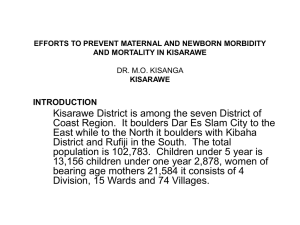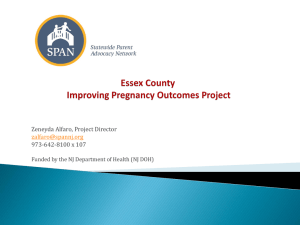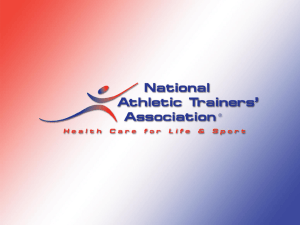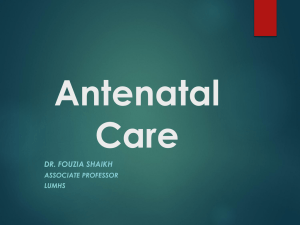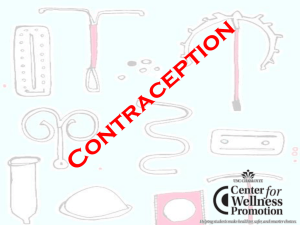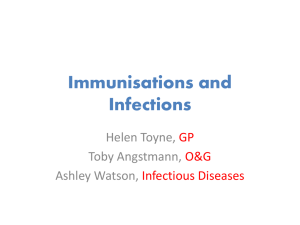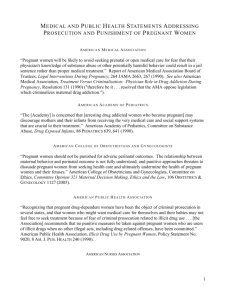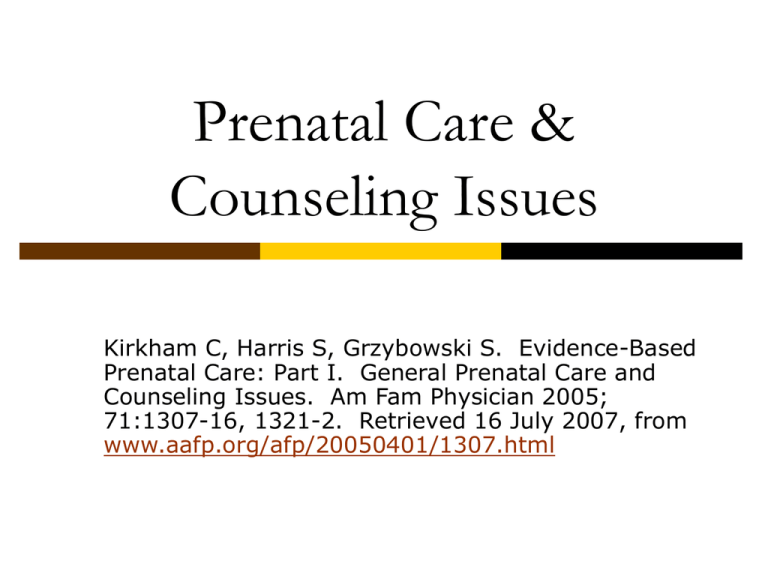
Prenatal Care &
Counseling Issues
Kirkham C, Harris S, Grzybowski S. Evidence-Based
Prenatal Care: Part I. General Prenatal Care and
Counseling Issues. Am Fam Physician 2005;
71:1307-16, 1321-2. Retrieved 16 July 2007, from
www.aafp.org/afp/20050401/1307.html
Prenatal Care
Ideally begins before conception and
includes
Preventive care
Counseling
Screening (risks to maternal and fetal health)
Maternity Care Calendar and Guidelines
www.maternitycarecalendar.com
Pregnancy is confirmed
Prenatal care plans & choice of caregiver
must be discussed
The initial visit should occur during the
first trimester
An average 7-11 prenatal visits/pregnancy
Choice of Caregiver…
Care provided by midwives, family
physicians, and obstetricians is equally
effective
Women were slightly more satisfied with
care from midwives and family physicians
Caregiver continuity reduces interventions
in labor and improves maternal
satisfaction
EDD (Estimated Date of Delivery)
EDD should be calculated by accurate
determination of the last menstrual period
(LMP)
Accurate dating is important for timing
screening tests and interventions, and for
optimal management of complications
Some research indicates that early
ultrasonography is more accurate than LMP at
determining gestational age
should be considered if LMP is uncertain
Counseling
The first 12 weeks of pregnancy are a
time of organogenesis and heightened
fetal vulnerability to teratogens
Counseling about risk behaviors is
appropriate…
Counseling Issues in Pregnancy
Air travel?
Hair dye?
Exercise?
Alcohol?
Hot tubs?
Sex?
Smoking?
Air travel
Safe for pregnant women until 4 weeks
before the EDD
Consider the availability of medical resources
at the destination
Lengthy trips are associated with
increased risk of venous thrombosis
http://www.cdc.gov/travel/pregnant.htm
Breastfeeding
Breastfeeding is the best feeding method
for most infants
Contraindications include maternal HIV
infection, chemical dependency, and use of
certain medications
Structured behavior counseling and
breastfeeding-education programs may
increase breastfeeding success
Exercise
Pregnant women should avoid activities
that put them at risk for falls or abdominal
injuries
At least 30 minutes of moderate exercise on
most days of the week is a reasonable activity
level for most pregnant women
Hair Treatments
Although hair dyes and treatments have
not been associated clearly with fetal
malformation, exposure to these
treatments should be avoided during early
pregnancy
Hot tubs and saunas
Hot tubs and saunas probably should be
avoided during the first trimester of
pregnancy
Maternal heat exposure during early
pregnancy has been associated with
neural tube defects and miscarriage
Labor and delivery
All pregnant women should be counseled
about what to do when their membranes
rupture, what to expect when labor
begins, strategies to manage pain, and
the value of labor support
“Labor support” = doula
Medications: prescription, over-the-counter,
and herbal remedies
Few medications have been proven safe
for use in pregnant women, particularly
during the first trimester of pregnancy
The risks associated with individual
medications should be reviewed based on the
patient's needs
http://www.cdc.gov/ncbddd/meds/
Sex
Sexual intercourse during pregnancy is
not associated with adverse outcomes
Substance use: alcohol
All pregnant women should be screened
for alcohol misuse
There is good evidence that counseling is an
effective intervention in decreasing alcohol
consumption in pregnant women and morbidity
in their infants
There is no known safe amount of alcohol
consumption during pregnancy
Abstinence is recommended
Substance use: illicit drugs
All pregnant women should be informed of
the potential adverse effects of drug use
on the fetus
Women who use illicit drugs often require
specialized interventions, ideally within a
harm-reduction framework
Admission to a detoxification unit may be
indicated
Substance use: smoking
All pregnant women should be screened
for tobacco use, and pregnancy-tailored
counseling should be provided to smokers
Smoking-cessation counseling and
multicomponent strategies are effective in
decreasing the incidence of low-birth-weight
infants
Workplace
Some working conditions, such as
prolonged standing and exposure to
certain chemicals, are associated with
pregnancy complications
Employment is associated with favorable
demographic and behavioral characteristics,
and generally is not associated with adverse
pregnancy outcomes
First Prenatal Exam
History & directed physical exam – detect
conditions associated with increased maternal
and perinatal morbidity and mortality
Cervical cancer screening (Pap)
NOTE: Pap tests performed in pregnant women may be
less reliable
Ectopic pregnancy & spontaneous pregnancy loss
Should be considered if risk factors, abdominal pain or
bleeding, are present
Routine Prenatal Visits
Fundal height
Maternal weight
Blood pressure measurements
Fetal heart auscultation
Urine testing for protein and glucose
Questions about fetal movement
Evidence supporting these practices is
variable…
Abdominal palpation
Abdominal palpation should be used to
assess fetal presentation beginning at 36
weeks' gestation
Abdominal palpation should not be done before
36 weeks' gestation because of potential
inaccuracies and discomfort to the patient
Blood pressure measurement
It is not known how often blood pressure
should be measured, but most guidelines
recommend measurement at each
antenatal visit
Further research is required to determine how
often blood pressure should be measured.
Evaluation for edema
Edema occurs in 80 percent of pregnant
women
Edema is defined as greater than 1+ pitting
edema after 12 hours of bed rest, or weight
gain of 2.3 kg (5 lb) in one week
It lacks specificity and sensitivity for the
diagnosis of preeclampsia
Fetal heart tones
Auscultation for fetal heart tones is
recommended at each antenatal visit
Heart tones confirm a viable fetus, but
there is no evidence of other clinical or
predictive value
It is thought that fetal heart tone auscultation
provides psychologic reassurance to the
mother, but this potential benefit has not been
studied
Fetal movement counts
Routine fetal movement counting should
not be performed
Symphysis fundus height measurement
Symphysis fundus height should be
measured at each antenatal visit
It is a simple, inexpensive test
Plotting the measurement on a graph is
suggested for monitoring purposes
Measurement of the symphysis fundus height
is subject to interobserver and intraobserver
error
Urinalysis
Dipstick urinalysis does not detect proteinuria
reliably in patients with early preeclampsia
Measurement of 24-hour urinary protein excretion is the
gold standard
Trace glycosuria also is unreliable, although
higher concentrations may be useful
*Some guidelines have encouraged discontinuation of
dipstick urinalysis; others retain this test as part of the
routine antenatal visit
Weight measurement
Maternal height and weight measurements
should be made at the first antenatal visit
to determine body mass index, which is
the basis for recommended weight gain in
pregnancy
Patients who are underweight or overweight
have known risks
Maternal weight should be measured at
each antenatal visit
Prenatal Education
Education is an important component of
prenatal care, particularly for women who
are pregnant for the first time
Physiologic changes that occur during
pregnancy
Preparation for the birthing process
Choices such as breastfeeding, etc.
Screening
A woman should understand
what screening tests are meant to detect
how they are conducted
possible risks to her and her fetus
the type of results that will be reported
(e.g., probability, risk)
the likelihood of false-positive or false-negative
results
the choices she will face once results are
obtained
Domestic Violence
Affects a significant number of pregnant women
and may put the fetus at risk
Integrating a standardized screening protocol into routine
history-taking procedures increases the identification,
documentation, and referral for intimate partner violence.
1.
2.
3.
Have you been hit, kicked, or otherwise hurt by
someone within the last year?
Do you feel safe in your current relationship?
Is there a partner from a previous relationship who is
making you feel unsafe now?
Blood Typing
Rh and ABO blood typing and screening
for irregular blood cell antibodies
first prenatal visit
Rh0D immune globulin (Rhogam) is
recommended for all nonsensitized Rh(-)
women at 28 weeks gestation and within
72 hours after delivery of an Rh(+) infant
Due to the risk of exposure and alloimmunization…
Rhogam should also be offered after
spontaneous or induced abortion
ectopic pregnancy termination
chorionic villus sampling (CVS)
amniocentesis
cordocentesis
external cephalic version
abdominal trauma
second- or third-trimester bleeding
Genetic Screening
All women should be offered serum marker
screening for neural tube defects and trisomies
21 and 18
Family history of genetic disorders?
Previous fetus or child who was affected by a genetic
disorder?
History of recurrent miscarriage?
Increased risk? amniocentesis or CVS may be offered
Disease-specific screening should be offered to
patients who belong to an ethnic group with an
increased incidence of a recessive condition
Disease
Risk groups
Carrier Frequency
Cystic fibrosis
Ashkenazi Jews
Caucasians
1 in 25 to 30
Tay-Sachs disease
Ashkenazi Jews
Cajuns
French Canadians
in Eastern Quebec
1 in 20 to 30
Canavan's disease
Ashkenazi Jews
1 in 40
a- and b-thalassemia
Africans
East Indians
Hispanics
Mediterraneans
Middle Easterners
Southeast Asians
1 in 10 to 75
Sickle cell anemia
Africans
1 in 11
Remember…
It is important that they understand what screening
tests are meant to detect, how they are conducted,
possible risks to her and her fetus, the type of results
that will be reported, the likelihood of false-positive or
false-negative results, and the choices she will face
once results are obtained.
Ultrasonography
Should be offered an ultrasound scan to search
for structural anomalies between 18 and 20 wks
Also helps to accurately determine gestational age,
detect multiple pregnancies, and placental location
Please note:
No evidence directly links improved fetal
outcomes with routine ultrasound screening
Diagnostic ultrasound exposure has not been
proven to harm the mother or fetus, but more
research on its risks is needed
Nutrition
Women should be counseled to eat a wellbalanced, varied diet
Caloric requirements increase by 340 to 450 kcal per
day in the second and third trimesters
Most guidelines recommend that pregnant
women with a normal body mass index gain
approximately 25 to 35 lb during pregnancy
<25 lbs: low birth weight and preterm birth
> 35 lbs: increased risk of macrosomia, cesarean
delivery, and postpartum weight retention
Dietary Supplements
Calcium
RDI is 1,000 to 1,300 mg per day
Routine supplementation with calcium to prevent
pre-eclampsia is not recommended
May be beneficial for women at high risk for
gestational hypertension or in communities with
low dietary calcium intake
Calcium supplementation has been shown to decrease
blood pressure and pre-eclampsia, but not perinatal
mortality
Folic Acid
Supplementation with 0.4 to 0.8 mg of folic acid
(4 mg for secondary prevention) should begin at
least one month before conception
prevents neural tube defects
RDA (in addition to supplements) is 600 mcg of
dietary folate equivalents (e.g., legumes, green
leafy vegetables, liver, citrus fruits, whole wheat
bread) per day
Folate deficiency is associated with low birth weight,
congenital cardiac and orofacial cleft anomalies, abruptio
placentae, and spontaneous abortion
Iron
Pregnant women should be screened for
anemia (hemoglobin, hematocrit) and
treated, if necessary
Iron-deficiency anemia is associated with
preterm delivery and low birth weight
Pregnant women should supplement with
30 mg of iron per day
Insufficient evidence?
Vitamin A
Pregnant women in industrialized
countries should limit vitamin A intake to
less than 5,000 IU per day
High dietary intake of vitamin A (i.e., more
than 10,000 IU per day) is associated with
cranial-neural crest defects
Vitamin D
Vitamin D supplementation can be considered in
women with limited exposure to sunlight (e.g.,
northern locations, women in purdah)
Evidence on the effects of supplementation is limited
RDA is 5 mcg per day (200 IU per day)
Vitamin D deficiency is rare but has been linked to
neonatal hypocalcemia and maternal osteomalacia
High doses of vitamin D can be toxic
Food Safety – Dietary Guidelines
Artificially sweetened foods and drinks
Use caution when consuming foods and
drinks containing saccharin
Known to cross the placenta and may remain
in fetal tissue
Aspartame, sucralose, and acesulfame-K
probably are safe in pregnant women
Women with phenylketonuria should limit
consumption of aspartame
Caffeine-containing drinks
Moderate amounts probably are safe
Some guidelines recommend limiting
consumption to 150 to 300 mg per day
Association between high caffeine consumption
and spontaneous abortion and low-birthweight infants
Confounding factors such as smoking, alcohol use,
nausea, and age cannot be ruled out
Dairy products
Avoid unpasteurized milk and milk
products
Toxoplasma and Listeria (case reports)
Avoid soft cheese (e.g., feta, Brie,
Camembert, blue-veined cheeses, Mexican
queso fresco)
Listeria (case reports)
Delicatessen foods
Avoid delicatessen foods, pâté, and meat
spreads
Listeria (case reports)
Eggs
Avoid raw eggs (e.g., Caesar salad,
eggnog, raw cookie dough)
Salmonella; salmonellosis can lead to
intrauterine sepsis (case reports)
Fruits and vegetables
Wash all fruits and vegetables before
eating them
Toxoplasma and Listeria (case reports)
Cutting boards, dishes, utensils, and
hands should be washed with hot, soapy
water after contact with unwashed fruits
and vegetables
Toxoplasma (case reports)
Herbal teas
Limit consumption of herbal tea
Teas containing ginger, citrus peel, lemon
balm, and rose hips probably are safe in
moderation
Avoid teas containing chamomile, licorice,
peppermint, or raspberry leaf
Few controlled trials have addressed the safety
of herbal preparations in pregnant women
Some herbal products are considered unsafe in
pregnancy
Leftover foods
Leftover foods should be thoroughly
reheated before they are eaten
Listeria (case reports)
Meat
Avoid raw or undercooked meat
Hot dogs and cold cuts should be reheated until
they are steaming hot
Listeria (case reports)
Liver and liver products should be eaten in
moderation
Toxoplasma (case reports)
Excessive consumption could cause vitamin A toxicity
Cutting boards, dishes, utensils, and hands
should be washed with hot, soapy water after
contact with uncooked meat
Toxoplasma (case reports)
Seafood
Avoid shark, swordfish, king mackerel, tilefish, and tuna
steaks. Limit intake of other fish (including canned tuna) to
12 oz (2 to 3 meals) per week.
Avoid refrigerated smoked seafood; avoid raw fish and
shellfish
Exposure to high levels of mercury in fish can lead to
neurologic abnormalities in women and their infants
Listeria; Parasites and Norwalk-like viruses (case reports)
Eat farmed salmon in moderation. Experts recommend
eating a variety of fish, rather than one or two kinds.
Increased levels of organic pollutants, including
polychlorinated biphenyls and dioxins, have been found in
farmed salmon



